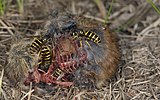Vespula
 Vosa ryšavá | |
| Vědecká klasifikace | |
| Říše | živočichové (Animalia) |
| Kmen | členovci (Arthropoda) |
| Třída | hmyz (Insecta) |
| Řád | blanokřídlí (Hymenoptera) |
| Podřád | žahadloví (Aculeata) |
| Čeleď | sršňovití (Vespidae) |
| Podčeleď | Vespinae |
| Rod | Vespula Thomson, 1869 |
| Některá data mohou pocházet z datové položky. | |
Vespula je rod sociálních vos, jehož zástupci jsou rozšíření především na severní polokouli (Eurasie, Severní Amerika). Jsou podobné vosám rodu Dolichovespula, ale mají vertikálně kratší hlavu, častěji hnízdí pod zemí a obecně jsou poněkud agresivnější. Hnízdo bývá zakládáno jen jednou oplodněnou samicí - královnou. Cyklus hnízda trvá od 3,5 měsíců do 8 měsíců, v teplejších oblastech mohou kolonie i přezimovat (hnízdo pak může dosáhnout obřích rozměrů, neboť v něm působí mnoho matek - královen).[1] Dospělci se živí sladkými šťávami, nektarem a medovicí, larvy jsou masožravé a dospělí jedinci pro ně loví rozličný hmyz a další malé bezobratlé. Do rodu Vespula se řadí nejznámější druhy vos a to vosa obecná a vosa útočná. Tyto druhy se staly i invazními živočichy a byly zavlečeny například do Austrálie, Jižní Ameriky, na Nový Zéland či do jižní Afriky.
Druhy
- Vespula acadica (Sladen, 1918)
- Vespula alascensis Packard, 1870
- Vespula arisana (Sonan, 1929)
- Vespula atropilosa (Sladen, 1918)
- Vespula austriaca (Panzer, 1799) – pavosa rakouská (sociální parazit vosy ryšavé)
- Vespula consobrina (Saussure, 1854)
- Vespula flaviceps (Smith, 1870)
- Vespula flavopilosa Jacobson, 1978
- Vespula germanica (Fabricius, 1793) – vosa útočná
- Vespula inexspectata Eck, 1991
- Vespula infernalis (de Saussure, 1854)
- Vespula ingrica Birula, 1931
- Vespula intermedia (du Buysson, 1904–05)
- Vespula kingdonwardi Archer, 1981
- Vespula koreensis (Rad., 1887)
- Vespula maculifrons (Buysson, 1905)
- Vespula nursei (Archer, 1981)
- Vespula orbata (Buysson 1902)
- Vespula orientalis (Linnaeus, 1771)
- Vespula pensylvanica (Saussure, 1857)
- Vespula rufa (Linnaeus, 1758) – vosa ryšavá
- Vespula rufosignata (Eck, 1998)
- Vespula shidai (Ish., Yam., Wagn., 1980)
- Vespula squamosa (Drury, 1770)
- Vespula structor (Smith, 1870)
- Vespula sulphurea (Saussure, 1854)
- Vespula vidua (de Saussure, 1854)
- Vespula vulgaris (Linnaeus, 1758) – vosa obecná
Galerie
- Vespula acadica
- Vespula alascensis na mršině
- Vespula atropilosa - detail hlavy
- Porovnání kresby na hlavách severoamerických vos rodu Vespula
- Porovnání kreseb na zadečcích deseti druhů vos rodu Vespula
- Královna parazitické pavosy rakouské
- Vespula maculifrons (Virginie)
- Vespula flaviceps (Japonsko)
- Vespula pennsylvanica porcují kobylku
- Vosy obecné na hnízdě
- Čerstvě vylíhlá vosa útočná. Okolo ní jsou larvy a kukly.
- Vespula squamosa
Reference
- ↑ ARCHER, Michael E. Vespine Wasps of the World. Behaviour, Ecology and Taxonomy of the Vespinae. Manchester: Siri Scientific Press, 2012.
Externí odkazy
 Obrázky, zvuky či videa k tématu Vespula na Wikimedia Commons
Obrázky, zvuky či videa k tématu Vespula na Wikimedia Commons - rod vosa Vespula Thomson, 1869 [online]. BioLib [cit. 2020-08-18]. Dostupné online.
- Bug Guide: Vespula
Média použitá na této stránce
Autor:
- Information-silk.png: Mark James
- derivative work: KSiOM(Talk)
A tiny blue 'i' information icon converted from the Silk icon set at famfamfam.com
Autor: IgorArenz, Licence: CC BY-SA 3.0
Einblick in ein geöffnetes Nest
Autor: Bob Peterson from North Palm Beach, Florida, Planet Earth!, Licence: CC BY-SA 2.0
The Southern yellowjacket (Vespula squamosa) is aggressive and quite dangerous when defending it's nest. Stumbling into the nest flyway or making ground vibrations too close to the entrance can get one swarmed! However, away from the nest while foraging for nectar, insects, rotting fruit and carrion, the yellowjacket is relatively amiable as long as you don't grab or insult her.
Here is one method to safely photograph yellowjackets using an Osprey and a striped mojarra fish (Diapterus plumieri): 1. Befriend an Osprey ("fish hawk") 2. Ask it to go catch a striped mojarra fish (any fish will do). 3. When it is done eating, it will drop it on the ground. 4. Wait while the fish decomposes. 5. Yellowjackets (& flies) will come. 6. Take photographs!
(Or you could just photograph them on rotting fruit but that wouldn't be a challenge :)
This Southern yellowjacket has been drawn to a rotting mojarra fish dropped by an Osprey (there were several yellowjackets and blue bottle flies racing around). Note the two distinctive longitudinal stripes on the mesoscutum (just behind the head) which are characteristic of the species. The wasp is standing on the scales of the fish. The ground nest of these yellowjackets is not far away and has been cautiously and nervously passed by yours truly many times over the last couple of years.Autor: Lynn S. Kimsey and James M. Carpenter, Licence: CC BY 3.0
Dorsal view of worker metasoma.
Autor: Judy Gallagher, Licence: CC BY 2.0
Eastern Yellowjacket - Vespula maculifrons, Leesylvania State Park, Woodbridge, Virginia
Western yellowjackets (Vespula pensylvanica), like many insects, act as critical decomposers and nutrient-recyclers. Here, the yellowjackets accomplish these crucial roles as they quickly devour a green bird grasshopper (Schistocerca shoshone).
Autor: ImagePerson, Licence: CC BY-SA 4.0
Brood cells in disturbed nest of German Wasp (Vespula germanica) and newly-hatched adult
Autor: Richard Bartz, Munich aka Makro Freak
Description: Vespula, as shown a Red Wasp (Vespula rufa), is a small genus of social wasps, widely distributed in the Northern Hemisphere
Autor: D. Sikes from Fairbanks, USA, Licence: CC BY-SA 2.0
Vespula alascensis making short work of a red backed vole in the frenetic race to supply their reproductive sisters with the protein they need.
Autor: Magne Flåten, Licence: CC BY-SA 3.0
Queen of red cuckoo wasp Vespula austriaca
Photo by: NPS / Alex Zaideman Collected by: L. Royer Park County, WY Yellowstone National Park June 21, 2016 Dunraven Road
Determined by: B. KondratieffAutor: harum.koh from Kobe city, Japan, Licence: CC BY-SA 2.0
クロスズメバチ.
www.inaturalist.org/calendar/harumkoh/2014/8/10Autor: Lynn S. Kimsey and James M. Carpenter, Licence: CC BY 3.0
Front view of face, antennae removed. Vpl. = Vespula.

























